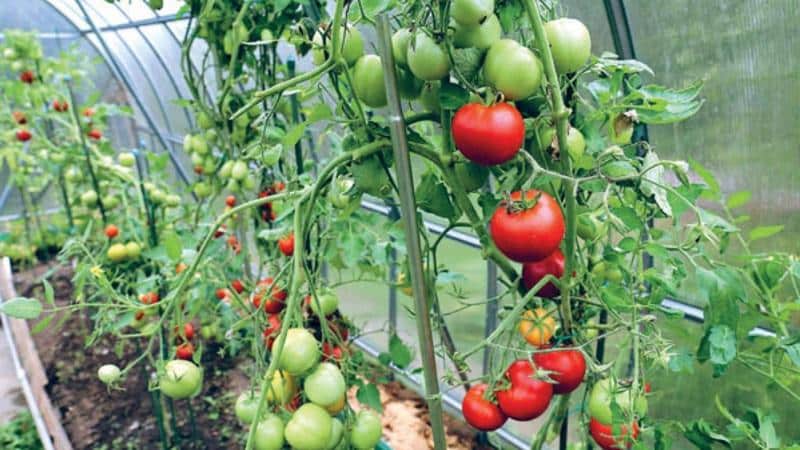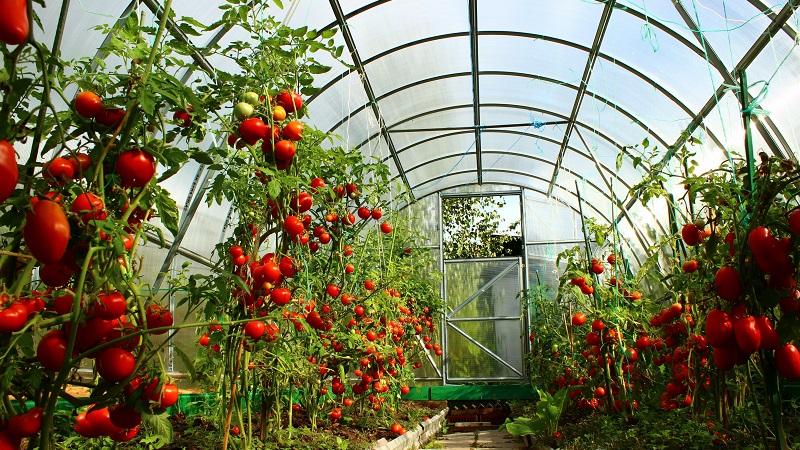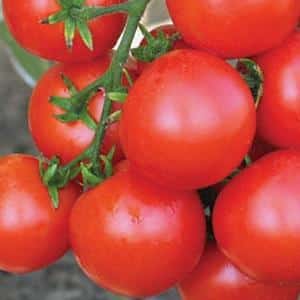Advantages and disadvantages of the Tsunami tomato, characteristics of the fruit and subtleties of cultivation
Before planting this or that variety of tomatoes, many people ask themselves: which one is better? Before you get an answer, you should decide why you want to grow tomatoes and what conditions you have for this.
If your goal is to consume fresh tomatoes, using them, for example, in salads, then the Tsunami variety is at your service. The sweet taste, juicy pulp and pleasant aroma, coupled with early ripening and large fruit size, make these tomatoes especially attractive for growing. Let's take a closer look at the features of this variety.
Characteristics and description of the variety
Bushes of the Tsunami variety can reach 60 cm in height and grow in 1-2 stems. The leaves of the plant are corrugated. During the growth process, 6-7 clusters appear, on each of which an average of five tomatoes grow.
Distinctive features
The fruits are distinguished by the following characteristics:
- weight of tomatoes - 230-250 g. Maximum - up to 300 g;
- pink colour;
- shape - flat and round, slightly ribbed;
- the pulp is very juicy, the skin is thin;
- tomatoes can be eaten fresh, used in salads and in the preparation of juices and ketchups.
Productivity
The fruits grow smooth and slightly ribbed; when they reach maturity, they acquire a crimson color. You can see examples in the photo. Great for any use: storing for the winter, cooking and eating raw.
With proper care, you can harvest 3-4 kg of tomatoes from one bush, which is considered an excellent yield indicator for this variety.

How to grow seedlings
Let's take a step-by-step look at how to properly grow Tsunami tomato seedlings.
Seed preparation
First, you need to prepare the seeds for planting and carry out preventive measures to treat them to protect against viral diseases with a disinfectant - a solution of potassium permanganate or “Fitosporin”.
Container and soil
The soil is prepared from a disinfected mixture of garden soil with compost, fertilizers and ash. It is necessary that the soil is nutritious, loose and permeable to air. The container should be shallow; it can be grown in peat pots.
Before sowing, moisten the seedling boxes and plant pre-treated seeds approximately 2-3 cm apart, covering them with a small (5-7 mm) amount of soil. Then cover and place the boxes close to heat, such as radiators.
When the first shoots begin to appear, place them on a windowsill or near a lamp with artificial lighting.
Growing and care
The first two weeks should be placed plants in the most illuminated place for 11-12 hours a day. The temperature at night should be about 12-14 degrees, and during the day - 15-16 degrees. In the following days it can be increased by 6-7 degrees with maximum illumination.
Important! Seedlings moderately watered, after one or two weeks they feed. After several true leaves appear, they are planted in cups or boxes with a distance between sprouts of 10-15 cm.
Seedlings ready for planting should have healthy green leaves, strong stems and well-developed roots. The optimal age for planting seedlings in the ground is 50-55 days.
How to grow tomatoes
Let's look at how to grow Tsunami tomatoes.
Landing
Since this variety is susceptible to various diseases, it is recommended to plant it in a greenhouse.
During disembarkation seedlings compost is added to the soil. Plants are planted at a distance of about 40 cm from each other, secured to pegs and watered.
Care
This variety requires the formation of bushes. This is done in a greenhouse with two stems. It is better to trim and tie leaves in the morning.
The basic rules of care are:
- maintaining the required temperature in the greenhouse - 17-20 degrees;
- using fertilizers - on days 10-15, add “Nitrophoska” (1 tbsp) and mullein (0.5 l) into the soil, dilute them in 10 l of water and pour a liter jar onto each plant;
- extermination of pests and treatment of diseases.
Also, perform pinching (removal of excess shoots) in a timely manner so that the plant does not lose the nutrients necessary for fruit ripening. Tomatoes should be weeded once every 2-3 days. Don't forget to water them every day.
Recommendations for growing Tsunami tomatoes:
- The plant is planted in early May. When the plant takes root in the soil, it is fed and tied up.
- The temperature should be around 18-24 degrees during the day and 15-18 degrees at night. It is necessary to ventilate the greenhouse or install a fan.
- To improve gas exchange, the lower leaves are cut off and mounded into the soil.
- Do not allow soil and air temperatures to rise: gray rot and brown spot may form.

Features and possible difficulties
To prevent the appearance of bacteria and infections in a humid environment, the greenhouse should be ventilated and the soil mulch. This retains moisture near the roots and reduces evaporation.
To maintain low air humidity, water the plants at the roots and in the morning.
Feeding is done before fruit set with a solution of mullein infusion, and then fertilized with minerals.
Important! All fertilizing is carried out only after watering the plants.
Diseases and pests
This variety is resistant to tobacco mosaic virus. Infected by late blight and cladosporiosis.
The use of crop rotation helps to protect plants. Plant tomatoes in place of cucumber and squash plants.
If there is a possibility of infection late blight, use protective equipment: Bordeaux mixture or copper oxychloride.
To get rid of wireworms, use “Bazudin”. When planting in small areas, it is better not to use chemicals - just monitor the plant and maintain a favorable environment.
The nuances of growing in open ground and greenhouses
Caring for tomatoes in greenhouse conditions is standard: favorable climatic conditions, fertilizing, disease treatment and pest control.
We plant tomatoes according to the 40x60 pattern so that the plants do not interfere with each other.
Important! At night, the temperature in the greenhouse should not be below 15 degrees. To avoid condensation, which often causes a number of diseases, install a fan.
Tomatoes should be planted in open ground in the first half of June and only when the weather is good. Place the plants in rows at a distance of 30-40 cm from each other, leaving 30-40 cm between the rows.
Make holes and water them well - about 1 liter per hole. Plants should be planted in the soil a little deeper than in greenhouses. Gardeners advise tearing off the lower leaves and lowering the stems as deep as possible when planting. After planting, water the plants and sprinkle the hole with soil.
Good results can be achieved by growing tomatoes under film covers or in steam beds. This speeds up the ripening of tomatoes and gives a higher yield.

Harvesting and application
The fruits are harvested in the summer when yields are high. In summer, when temperatures are high, it is necessary to ensure that the greenhouse is always ventilated.
If there is no heating in the greenhouse, then collect tomatoes before the onset of cold weather - the fruits may freeze. If you have a heater, then you can harvest at any time.
The fruits can be consumed both raw and prepared: they can be used for canning, salads, preparing various dishes, ketchup, tomato juice.
Advantages and disadvantages of the variety
The main advantage of the Tsunami variety is its juicy, sweet pulp. In addition, its rich yield is noted.
The disadvantage is the variety's susceptibility to diseases, especially late blight. It is necessary to take additional preventive measures to preserve the harvest.
Reviews
 On the Internet you can always read reviews from summer residents about their experience in growing Tsunami tomatoes. Here are examples of some of them:
On the Internet you can always read reviews from summer residents about their experience in growing Tsunami tomatoes. Here are examples of some of them:
Pauline: “I’ve been growing Tsunami for two years. I wanted to try it in open ground, but I was afraid of problems with the weather, so I planted it in a greenhouse. The tomatoes turned out large. I fought aphids twice. Otherwise the variety is very good, juicy and sweet.”
Dmitriy: “I’ve been growing Tsunami for over five years now. Firstly, the yield is very high and I like the taste. Secondly, if you know what to do, then care is simple.I grow it all year round, as it grows in my greenhouse.”
Conclusion
The Tsunami tomato variety is an excellent option for planting in greenhouses and greenhouses. The only negative is susceptibility to diseases, but they can be prevented if you properly care for the plant.
Due to its fertility and excellent taste, the variety can be called one of the best. Follow the tips for growing it and reap a great harvest.